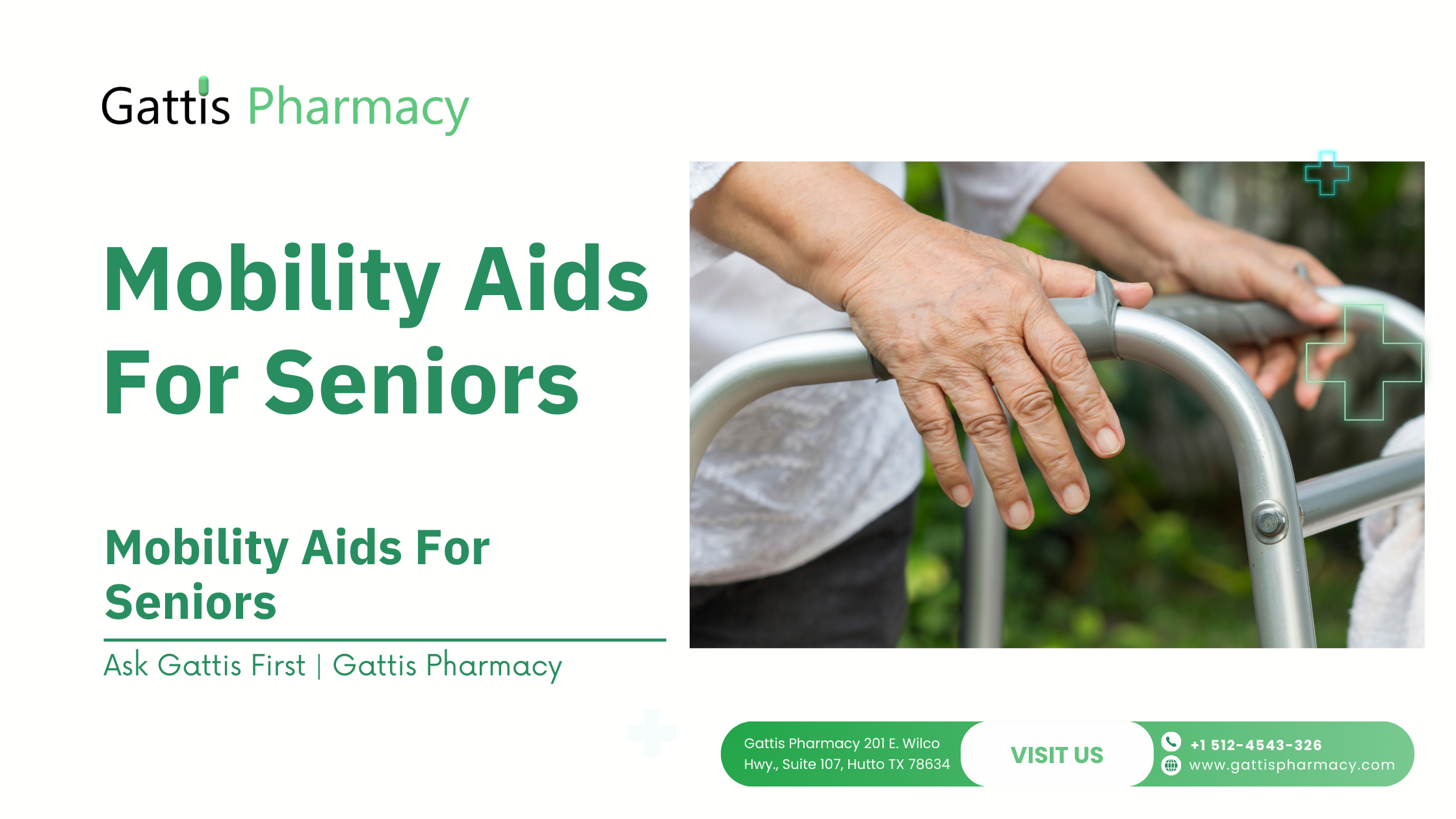As people age, mobility often becomes more challenging, and using mobility aids for seniors can mean a big difference in safety, independence, and quality of life.
Choosing the right aid and knowing how to use it safely helps reduce falls, improve confidence, and let seniors stay active with less assistance.
This guide will help you discover mobility aids for seniors, what to consider when choosing one (strength, safety, environment), and how Gattis Pharmacy can help you pick & maintain the right device.
What Are Mobility Aids & Who Needs Them
Mobility aids are devices that assist with movement or support for people who have difficulty walking, standing, or navigating their environment.
According to MedlinePlus, mobility aids include things like canes, walkers, wheelchairs, motorized scooters, crutches, and even environmental modifications such as ramps or handrails. (MedlinePlus)
Seniors may benefit from mobility aids when they have:
- Weakness in legs or poor balance
- Joint pain, arthritis, or conditions that limit range of motion
- Recovery from surgery or injury
- Risk of falling or frequent slips/trips
- Chronic illnesses (e.g. neurological, musculoskeletal) that reduce endurance
Types of Mobility Aids
Here are common mobility aids, what situations they are best for, what to watch out for, and tips for selecting:
- Canes
Best when you need mild support for balance, perhaps just one side of the body.
Pros: light, easy to store, inexpensive.
Cons: minimal support; not suitable if balance or weight bearing is severely impaired.
Tips: use a cane with a comfortable grip, choose one adjustable to wrist-height so your elbow is slightly bent when holding it.
- Walkers & Rollators
- Walkers (non-wheeled) offer strong support, especially if balance is very poor. Rollators are walkers with wheels, often front wheels or four-wheeled; many have a seat and a basket.
- Pros: good stability; rollators make movement easier over longer distances because you don’t have to lift them fully.
- Cons: walkers are bulkier and harder to maneuver; rollators less stable than non-wheeled walkers; both require a safe environment (smooth floors, wide hallways).
- Tips: pick one with brakes (for rollators), matching height; test indoors and outdoors if you will use both; ensure you can fold or transport it if needed.
- Wheelchairs & Mobility Scooters
- Wheelchairs are for people who cannot walk safely or whose endurance is very low.
- Manual wheelchairs require upper body strength; power wheelchairs remove that burden.
- Scooters are more like motorized chairs that may provide better balance outdoors.
- Pros: major boost in mobility, minimal physical effort (especially powered options), useful for longer distances.
- Cons: they are heavier, require storage space, might be harder to use indoors if tight spaces; powered ones require battery maintenance.
- Tips: measure doorways; check turning radius; ensure weight capacity; for power models, check battery life, whether charging is convenient at your home.
- Crutches & Forearm Crutches
- Mostly for temporary use when a leg or foot can’t bear weight (after injury or surgery).
- Pros: allow offloading weight, aid recovery.
- Cons: require upper body strength; uncomfortable underarms or for prolonged use; not ideal for long-term mobility.
- Tips: get properly fitted, use padding, follow guidance on correct usage to avoid strain.
- Specialized & Environmental Aids
- These include ramps, stairlifts, grab bars, transfer boards, patient lifts and devices to assist moving from chair to bed safely.
- Pros: help adapt the home environment to reduce risk; help caregivers too; promote safety and dignity.
- Cons: can be expensive; may need installation; may require professional assessment.
- Tips: assess your home layout; focus on areas with frequent risk (stairs, bathroom), choose sturdy and properly installed equipment.
Safety, Fit & Training: Making the Aid Work Well
Having a mobility aid is only part of the solution. To use it well and stay safe:
- Get properly fitted. Height, handle grip, weight capacity, seat height (for chairs/scooters) all matter. A wrong-fit aid can cause strain, falls, discomfort.
- Practice using the aid in safe settings first. Learn posture, how to step, move, turn, use brakes (if applicable), transfer in and out of chairs.
- Inspect your aid regularly: check wheels, rubber tips, brakes, joints. Replace worn parts promptly.
- Maintain cleanliness, dry any moisture; store in a dry place to avoid rust or deterioration.
- Be aware of your environment: avoid slippery surfaces, tripping hazards, narrow or cluttered paths. Ensure you have ramps or threshold access where needed.
How Gattis Pharmacy Helps You Choose, Use, and Maintain Mobility Aids
Here’s what Gattis Pharmacy offers to make choosing and using mobility aids easier:
- Personalized assessment: we help you evaluate strength, balance, endurance, and home layout to select the right type.
- Advice on fitting and comfort: helping you choose aids that align with your body dimensions, home access, and daily needs.
- Guidance on insurance / Medicare paperwork: ensuring you understand prescriptions, medical necessity documentation, supplier selection.
- Ongoing support: checking parts, recommending maintenance (e.g. replacing tips, checking brakes), ensuring the aid remains safe and functional over time.
Conclusion
Mobility aids play an important role in helping seniors stay safe, independent, and confident in their daily lives. Whether it’s a cane, walker, or wheelchair, the right aid can make all the difference.
At Gattis Pharmacy, we don’t just provide these products—we provide guidance, care, and a friendly hand to help you or your loved one choose the best option.

